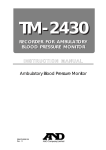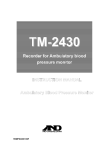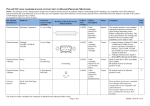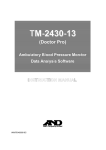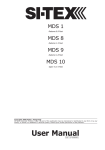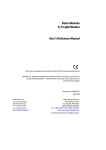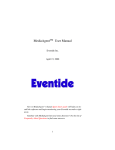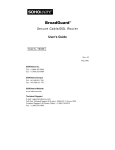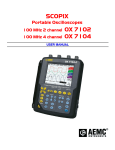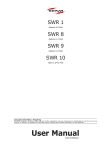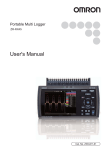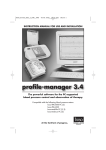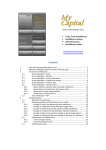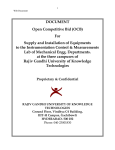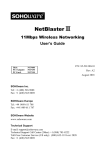Download Recorder for Ambulatory blood pressure monitor INSTRUCTION
Transcript
TM-2430 Recorder for Ambulatory blood pressure monitor INSTRUCTION MANUAL Ambulatory Blood Pressure Monitor 1WMPD4000136A Note This manual and or the TM-2430 may be changed at any time to improve the product without notice. Contents Before use Compliance ---------------------------------------------------------------------------------------- 2 Definitions ------------------------------------------------------------------------------------------ 2 Precautions for Use ------------------------------------------------------------------------------ 3 Notes on the Blood Pressure Recorder ----------------------------------------------------- 5 Welcome Welcome and Intention -------------------------------------------------------------------------- 6 Product overview Packing List and Component Names -------------------------------------------------------- 6 Display ---------------------------------------------------------------------------------------------- 8 Symbols ------------------------------------------------------------------------------------------- 8 Specifications Features -------------------------------------------------------------------------------------------- 9 Functions and Specifications ------------------------------------------------------------------ 9 The complete procedure for use Step by Step Procedure ----------------------------------------------------------------------- 13 Initializing the recorder Replacing Batteries ---------------------------------------------------------------------------- 15 The State of Turning on the Recorder ----------------------------------------------------- 16 Parameters for the Display and Clock ----------------------------------------------------- 16 Selection for the Automatic Measurement ----------------------------------------------- 18 Deleting Old Data ------------------------------------------------------------------------------ 22 Resetting the Recorder ----------------------------------------------------------------------- 22 Preparing the patient Patient Instructions ----------------------------------------------------------------------------- 23 Use of the Cuff Cover ------------------------------------------------------------------------- 24 Attaching the Cuff and Recorder ----------------------------------------------------------- 24 Preparation of the Carrying Case ---------------------------------------------------------- 26 Operation Automatic Measurement (by Programed Time Intervals) ------------------------------ 27 Manual Measurement ------------------------------------------------------------------------- 27 To Stop a Current Measurement ------------------------------------------------------------ 27 Data transfer Data Transmission to a Printer -------------------------------------------------------------- 28 Data Transmission to a Computer Using Analysis Software ------------------------- 30 Options and accessories Analysis Software and Communication Cables ----------------------------------------- 31 Cuffs and Other Accessories ---------------------------------------------------------------- 32 Maintenance Checking Accuracy ----------------------------------------------------------------------------- 33 Cleaning the Cuff and Recorder ------------------------------------------------------------ 34 Periodical inspection ---------------------------------------------------------------------------- 34 Problem Solving -------------------------------------------------------------------------------- 34 Error Codes -------------------------------------------------------------------------------------- 35 Index ----------------------------------------------------------------------------------------------- 37 Page 1 Before use Compliance Compliance with European Directive 93/42 EEC for Medical Products The device conforms to the following requirements: European Directive 93/42 EEC for Medical Products; Medical Products Act; European Standards for Electrical Medical Equipment EN60601-1 (General Safety Provisions), EN60601-2-30 (Particular Requirements for the Safety of Automatic Cycling Indirect Blood Pressure Monitoring Equipment), EN60601-1-2 and EN55011 (Electromagnetic Compatibility); European Standards pertaining to Non Invasive Blood Pressure Instruments EN1060-1 (General Requirements), EN1060-3 (Supplementary Requirements for Electromechanical Blood Pressure Measuring Systems). The above is evidenced by the CE mark of conformity accompanied by the reference number of a designated authority. This device is designed for adults only. Compliance with FCC Rules Please note that this equipment generates, uses and can radiate radio frequency energy. This equipment has been tested and has been found to comply with the limits of a Class A computing device pursuant to Subpart J of Part 15 of FCC rules. These rules are designed to provide reasonable protection against interference when this equipment is operated in a commercial environment. If this unit is operated in a residential area it might cause some interference and under these circumstances the user would be required to take, at his own expense, whatever measures are necessary to eliminate the interference. (FCC: Federal Communications Commission in the U.S.A.) Compliance with the Australian EMC Framework The device conforms to the following requirements: EMC Emission standard for industrial, Scientific & Medical equipment AS/ NZS 2064-1997, EMC Generic Immunity standard AS/ NZS 4252. 1-1994. The above is evidenced by the C-Tick label. Definitions SYS DIA DSD Exhaust Constant exhaust Exhaust velocity During a measurement Interval bpm Systolic Blood Pressure Diastolic Blood Pressure The Difference between Systolic Blood Pressure and Diastolic Blood Pressure. This means "releasing the cuff air as soon as possible". This means "releasing the cuff air in a constant depressurization rate". This means the rate of depressurizing the cuff air. This means "a period between the start of cuff inflation and the end of exhausting the air". This is called "block". A block consists of a start time and frequency. beats per minute. Page 2 Precautions for Use Precautions Batteries Use alkaline batteries (LR6 type, AA type, Mignon) or suitable Ni-Cd batteries. Do not mix new and used batteries in the recorder. Remove the batteries from the recorder, if it will not be used for a long period of time and unless there is no risk of a SAFETY HAZARD arising. A malfunctioning recorder If the recorder malfunctions, stop the operation, attach a note "Do not use this recorder" and store in a safe place to avoid mis-use. Training Instruct the patient on how to stop the operation if there is an abnormal measurement, and how to remove the cuff if there is excessive arm pain. Advise the patient on how to cope with mis-operation and contingencies Repair Do not open the recorder case. Contact the nearest A&D office if you have questions. Blood pressure measurement Use the recorder for adult. The recorder may not make a measurement when a patient has continuous arrhythmia or the recorder senses noise due to the patients movement. Please check measurement values by other methods, if you suspect an value. Do not use this recorder on a person who is using a heartlung machine and a defibrillator. Do not use this recorder on a person who is critical or is in an intensive care unit. Saving power Turn off the power switch when not in use. Please transfer the data as soon as possible. All measurement data, clock parameters, measurement parameters and internal system parameters are preserved by backup battery when turning the power switch off. The backup battery life is few days. Data in memory A built-in backup battery keeps the important data in memory while replacing the main batteries. However it works for a short period of time, perform the battery replacement swiftly, or you may lose measurement data, the clock setting information and Page 3 automatic measurement condition data. The period varies depending on the battery condition. The backup battery may take 24 hours or more to be fully charged (depending on the battery condition). The built-in backup battery (rechargeable) as well as the primary battery (not rechargeable) will deteriorate along use, which causes to decrease its capacity. The built-in backup battery will deteriorate due to repetitive backup operations. To prevent the sudden drop of the built-in battery life, observe the following: Before using the monitor for the first time after purchase or after an extended period of no use, charge the battery fully. It takes 24 hours or more with the power switch turned on. Charging can be performed during measurement. After measurement, leave the battery inside and the power switch turned on. Under this condition, the built-in battery will not deteriorate. (This is true with the "B" sign displayed.) When the monitor is not to be used for a month or longer, turn the power switch off to prevent the main batteries from leaking. During an extended period of no use, the built-in battery will deteriorate. To prevent the situation, use the monitor regularly. When the power switch is turned on and off after a short period of use, the built-in battery will not be fully charged and the battery life will decrease. Avoid this situation. Cuff Close the cuff fastener properly when attaching the cuff to a patient or replacing the cuff cloth. If the fastener is closed incorrectly, inflating cuff may damage this cuff. The cuff contains dry natural rubber. Page 4 Notes on the Blood Pressure Recorder Storage Do not store the recorder in the following places. Where the recorder might be splashed with water or other liquids. If the recorder soaked, it needs a repair. (Do not use the recorder.) Where the temperature and humidity are high, or in direct sunlight. Where the recorder may be influenced by vibration or shock. Where there is dust, salt or sulfur. Where medicines are stored, or medicines are evaporating. Before use Cover the RS-232C terminal using the rubber cap, to avoid dust. Confirm that the recorder works correctly and measurement values are proper. Confirm that the cuff and air house are connected properly. Confirm parts of contact with patient directly. Keep clean for these parts. Use clean cuff cover because of contact with patient directly. Clear the old data before starting a new measurement. Avoid strong magnetic field and static electricity. Do not use this recorder with a high frequency surgical equipment. During use The recorder should be operated by a physician who knows it well. Use the recorder only during the time of diagnosis or medical treatment. Stop the use, if the patient feels pain in his arm or the recorder does not measure properly. It may reduced the measurement cycle due to environment. When an inside part of the recorder has been soaked (wetted), turn off the power switch and request service to your supplier or the A&D service group. After use Clean the recorder, cuff and accessories for the next use. Do not pull or kink hoses. Do not use organic solvent, antiseptic solution, etc. Turn off the power switch after measurement. Please use the original box for transportation. Periodic maintenance The recorder is a precision instrument. Please check all functions (every year) periodically. Contact your nearest A&D office for this inspection. Environmental protection If you disuse the recorder, remove Ni-Cd battery and built-in Li battery from this recorder. Disuse Ni-Cd battery to its exclusive trash can because of recycling it. Dispose of Li coin battery in the recorder as dangerous object properly. Page 5 Welcome Welcome and Intention Thank you for your Purchase! The A&D TM-2430 ambulatory blood pressure recorder enables you to accurately take a patient's blood pressure, automatically, at different preset times throughout a 24-hours period. Recently, in the treatment of patients with hypertension, there has been an increasing need to prescribe medication according to the particular blood pressure fluctuation pattern of the patient. These patterns can be made more evident by using the TM-2430 recorder, and analysis by a physician. This manual will explain in simple language how this recorder works. Patient This blood pressure recorder is designed for an adult patient. Environment This blood pressure recorder is used in a hospital and / or patient’s home. Product overview Packing List and Component Names When you open this box, make sure you have everything as shown here: Instruction manual 1 Blood pressure recorder (Main unit) Carrying case 1 Shoulder band 1 Belt 1 Cuff covers for adult cuff 2 Activity record sheets 10 Adult cuff for left arm 1 1 Page 6 Yellow mark Battery cover Air hose Auto ON/OFF key Shoulder band Adult cuff for left arm Start Stop key Air hose plug Air socket Carrying case Belt Reset key Power switch RS-232C terminal Alkaline batteries (type LR6, type AA, Mignon) The batteries are not included in this pack. Name Power switch Functions This is the main power switch. At the OFF state, all data and parameters are preserved by an backup battery. This backup battery life is approximately 10 days with the power off. AUTO ON/OFF key ・When you press and hold the AUTO ON/OFF key, the automatic measurement is started or stopped alternately. ・When you press the AUTO ON/OFF key at mode II of the automatic measurement, "S" is displayed or turned off alternately. This sign changes the interval for sleep. START STOP key ・ When you press the START STOP key, a blood pressure measurement is started at once. ・When you press and hold the START STOP key for approx. 3 seconds, the recorder proceeds to "Selection for the automatic measurement". ・When you press and hold the START STOP key for approx. 6 seconds, the recorder proceeds to "Parameters for the display and clock". ・When you press and hold the START STOP key for approx. 9 seconds, the recorder proceeds to "Deleting old data". RS-232C terminal This terminal is used for data output to a printer or computer. The optional RS-232C cable is necessary to output the data. Reset key All data and parameters are deleted. Page 7 Display Sleep sign Auto mode sign Low battery sign Full memory sign Sign A S B M Sign Setup sign of automatic measurement Systolic Blood Pressure display Diastolic Blood Pressure display Setup sign of display and clock Pulse display Error display ex. "Set the clock" Clock display Name Arrow Functions The arrow points to the kind of current display in the measurement result and function mode. Automatic "A" is displayed when the automatic measurement is selected. measurement When you press and hold the AUTO ON/OFF key, this sign is turned on or off alternately. Sleep When you press the AUTO ON/OFF key while in mode II of the automatic measurement, "S" is displayed or turned off alternately. With the "S" turned off, the time interval is 15 minutes. With the "S" turned on, the time interval is 30 minutes. Low battery When the recorder can not operate all functions due to low battery, this sign is displayed. The clock is still displayed. Please replace the batteries at once. Full memory When data memory is at full capacity, this sign is displayed. In this case, you can not perform another measurement. Transfer the data save in other media and delete. Then the "M" turns off. Symbols Turning on the recorder. Turning off the recorder. Direction guide to install batteries. Direct current. Serial number. Date of manufacture. Attention symbol. "See instruction for use." Recorder, Cuffs and tubings are designed to have special protection against electric shocks. Page 8 Specifications Features Portability The recorder weighs approx. 215g (including batteries) and is palm top size, because a micro-pump is used. The recorder is powered by LR6 type (Mignon) alkaline batteries. It is possible to replace the LR6 type batteries with Ni-Cd rechargeable batteries. Operation & management Clock and automatic measurement parameters may be set as needed. If you connect to a computer and use the optional software, clock and automatic measurement parameters can be set easily. There are three modes for automatic measurement. The recorder can transmit data to a printer directly. (An adaptable printer is necessary to print the data. Refer to Section "Data Transmission to a Printer" for specifications of the printer.) The recorder has the built-in chargeable coin Li battery to keep the clock and automatic measurement parameters. Analysis The time interval may be changed as needed. The patient's blood pressure can be measured immediately at any time. If you use the optional software, you can analyze the data widely. Smart measurement The measurement time is shortened by proper exhaust velocity control. The exhaust velocity adjustment is unnecessary, because the constant exhaust is properly controlled. In the automatic measurement, these inflation value and stop value at exhaust is managed to reduce the measurement time. Functions and Specifications Blood pressure measurement There are two ways of blood pressure measurement. Automatic measurement----- This automatic measurement works in accordance with internal clock, preset time intervals and preset mode. The measurement data is saved in memory. Manual measurement ---------Any time you press the START STOP key, a blood pressure measurement is performed immediately. The measurement data is saved in the memory. Page 9 Automatic measurement This measurement starts or stops using the AUTO ON/OFF key. When this measurement is started, the recorder begins to work in accordance with preset time intervals from the preset time of the internal clock. Refer to "Selection for the automatic measurement". In the automatic measurement, an "A" appears in the upper left of the display. The recorder automatically measures the patient's blood pressure at the time that is pointed out by "the frequency" and "the start time" (by the programed time intervals). When a measurement error occurs and there is 8 minutes until the next measurement, the measurement is retried after approx. 30 seconds. If a measurement is retried, only the data from the retry is saved. The recorder automatically adjusts the proper pressure, exhaust velocity and end of measurement. Refer to "Selection for the automatic measurement" and "Automatic measurement by programed time intervals" about operation and entering parameters. Stopping a measurement If you press the START STOP key during a measurement, the recorder exhausts the air and stops the measurement. Concealing the measurement value This function works only while using automatic measurement. This function does not display the SYS, DIA or pulse rate for the automatic measurement, but the data is saved in memory. This function can select "reveal" or "conceal" at "Parameters for the display and clock". Refer to this section. If you select "conceal", the recorder displays the clock during a measurement. If you reset the recorder, this parameter is set to "reveal". Pressurization The pressure is automatically selected by the recorder while in the automatic measurement mode. The first pressure is set to approx. 185 mmHg. This value automatically varies to the proper value after first measurement. If the first inflation is not successful, the recorder retries twice. If you reset the recorder, the first inflation value is set to 185 mmHg. Memory The recorder can store 300 sets of data (the memory capacity is 300). A data set consists of a SYS, a DIA and a pulse rate. When memory becomes full, the recorder displays an "M". Until you clear the data, you can not measure blood pressure. When the recorder saves data for more than one patient, data management becomes complication. We encourage that a patient's data is recorded, transferred and is cleared from memory. Page 10 When a "B" is displayed, the backup batteries that is preserving a patient’s data are weak. Please transfer the data and save it to other media as soon as possible. ID number If you reset the recorder, the ID number is set to "1". The ID number can be set using the optional software. Performance specifications Measurement method Pressurization Oscillometric micro-pump Display range 0 ~ 320 mmHg Automatic measurement 85 ~ 300 mmHg(Fitted) Manual measurement 185 mmHg (Fixed) Measurement range Systolic Blood Pressure 60 ~ 280 mmHg Diastolic Blood Pressure 40 ~ 60 mmHg Pulse rate 30 ~ 200 bpm +3 mmHg Accuracy Pressure Blood pressure Conforming to 1992 AAMI standard +5 % Pulse rate Minimum display division Pressure 1 mmHg Pulse rate 1 bpm Depressurization Constant exhaust Controlled ceramic valve Exhaust Ceramic valve Measurement Automatic measurement Manual measurement Number of measurement Apporx. 200 times (It may reduce this number due to environment and capacity of Ni-Cd batteries) Memory Up to 300 sets of data Display Normal Clock During a measurement Pressure value After a measurement SYS, DIA and pulse rate Error code, function of concealing the measurement data Clock 24-hours (1997~2096year, automatic leap year setting) Batteries 3 x Alkaline battery (type LR6, type AA, Mignon) or 3 x Ni-Cd battery (type AA, Mignon) Type of protecting Internally powered equipment type BF against electric shock CE Marking The label of the medical device 0366 by the EC directive. C-Tick Marking The certification trade mark registered N92 to the ACA by the Trademark office. AAMI : Association for the Advancement of Medical Instrumentation ACA: the Australian Communications Authority CE marking and C-Tick marking are labeled only where they are required. Page 11 Interface Connected to a computer, you can output the data and enter parameters. Connected to a printer, you can print the data. EIA RS-232C, Asynchronous, bi-directional, half duplex Baud rate 9600 bps Data bits 8 bits Stop bits 2 bits X parameter Used (for computer) Not used (for printer) Parity None Code ASCII Start bit Stop bits Data bits Environment specifications Operating environment Transport and Storage 。 。 。 。 + 10 C ~ +40 C (+50 F ~ +104 F), Less than 85%RH * 。 。 。 。 - 20 C ~ +55 C ( -4 F ~ +131 F), Less than 95%RH * * Non Condensing Physical specifications Dimensions Weight 72(W) x 100(D) x 27(H) mm 2.8(W) x 3.9(D) x 1.0(H) in. Approx. 215 g (0.47lb) excluding cuff SYS/INTERVAL DIA PULSE/TIME 72 START STOP AUTO ON/OFF 0 1 2 3 4 5 6 7 8 AIR 27 9 0 1 2 100 UNIT:mm Page 12 The complete procedure for use A Step by Step Procedure Step 1 Battery replacement. Replace with new alkaline batteries (note direction). Refer to page 14, "Replacing Batteries". Step 2 Turn on the recorder using the power switch. Step 3 With the recorder turned on, select any operation to set the state. Step 3 Case 1 Case 1 Normal Normal state The buzzer is sounded once and the clock is displayed. You can use this recorder at once. The recorder stores parameters for "display and clock" and "automatic measurement". Please proceed to Step 5 . Case 2 Step 1 Step 2 Error state Case 2 Error When the recorder displays the error code, it is necessary to set up parameters for "display and clock" and "automatic measurement". Please proceed to the next step. Step 4 Set up parameters for "display and clock". When you use automatic measurement, set up parameters for automatic measurement. Refer to "Parameters for the Display and Clock" and "Selection for the Automatic Measurement". Please proceed to Step 6 . Step 5 Set up new parameters for "display and clock" and "automatic measurement", if necessary. Step 6 Delete the old data stored in the recorder. Refer to the section "Deleting Old Data". Step 6 Step 7 Explain the "Patient Instructions" and "Notes on the Blood Pressure Recorder "to the patient. Step 7 Step 4 Step 5 Next page Page 13 Previous page Step 8 Attach the cuff to the patient. Refer to "Attaching the Cuff and Recorder". Step 9 Attach the carrying case to patient and insert the recorder. Refer to "Attaching the Cuff and Recorder". Step10 Start the automatic measurement. The recorder displays an "A". Refer to "Automatic Measurement". Step11 The recorder starts the automatic measurement sequence. Check the recorder using the manual measurement with relaxed, but correct posture. Refer to "Manual Blood Pressure Measurement". Step12 When using automatic measurement, consider the following. Consider the sections "Patient instructions" and "Notes on the Blood Pressure Recorder". When the patient uses mode II of automatic measurement, press the AUTO ON/OFF key with each rising and going to bed. Step13 When the automatic measurement sequence is finished, turned off "A" sign. Refer to "Automatic Measurement". Step 8 Step 9 Step 10 Step 11 Step 12 Step 13 Step14 Detach the cuff and recorder from the patient. Step 14 Step15 Transfer the patient’s data and save it to other media. Step 15 Refer to "Data transfer". Step16 Clean the cuff and recorder and place in storage. Refer to the sections "Before use" and "Maintenance". Step 16 End Page 14 Initializing the recorder Replacing Batteries Caution When "B" is displayed before a measurement, the recorder can not make a measurement. Please replace the new batteries before using. If "B" is displayed during the measurement, stop the measurement and replace the new batteries at once. Use alkaline batteries or the specified rechargeable batteries for the recorder. Do not use new and used batteries at the same time. Steps for replacing the batteries Step 1 Open the battery cover. Step 2 Turn off the power switch. Step 3 Replace with new batteries. ( note the direction, "+" and "-".) Step 4 Turn on the power switch. Step 5 Close the battery cover. Battery cover Step 1 Step 5 Step 4 Step 2 Power switch Step 3 New alkaline batteries Used batteries Page 15 The State of Turning on the Recorder There are three types of state when the recorder is turned on. Select a operation. Refer to the section "The complete procedure for use" about use. Action when the recorder is turned on. The buzzer sounds once and the clock is displayed. (Normal state) The buzzer is sounded once and is displayed blinking. The buzzer sounds four times and is displayed blinking. State of recorder The recorder storage parameters of "display and clock" and "automatic measurement". All parameters are lost. Treatment (Operation) You can use the recorder at once. Set up parameters of "display and clock" and "Automatic measurement". The state after reset. All parameters are lost. Parameters for the Display and Clock This setting selects the display during automatic measurement sequence and adjusts the clock parameters. The sequence number tells you which parameter you are adjusting. Display & key Sequence number Selecting a sequence number Parameter Selecting a parameter Sign of setting up parameters for display and clock Items Sequence Value & Meaning of parameters number range 0 Displaying clock only in automatic measurement 1 Displaying pressure and result in automatic 1 measurement 5 00 ~ 99 Years (1997 ~ 2096) 6 01 ~ 12 Month 7 01 ~ 31 Day 8 00 ~ 23 Hour 9 00 ~ 59 Minute Page 16 Steps for setting the display and clock This explanation uses the following examples. ex. After reset, the measurement value is not displayed. The clock is adjusted to 1997/ 05/ 27 14:28. Step 1 Press and hold the START STOP key for approx. 6 seconds. The recorder displays clock. START STOP for adjusting the display and AUTO ON/OFF Step 2 Press the AUTO ON/OFF key so as to display . (A selection where a clock is displayed only in automatic measurement) Step 3 Press the START STOP key. The current year is displayed. START STOP Step 4 Press the START STOP key. The current month is displayed. START STOP Step 5 Press the AUTO ON/OFF key to display 5 (for May). AUTO ON/OFF Step 6 Press the START STOP key. The current day is displayed. START STOP Step 7 Press the AUTO ON/OFF key to display 27 (27th day). AUTO ON/OFF Step 8 Press the START STOP key. The current hour is displayed. START STOP Step 9 Press the AUTO ON/OFF key to display 14 (14th hour). AUTO ON/OFF Step10 Press the START STOP key. The current minute is displayed. START STOP Step11 Press the AUTO ON/OFF key to display 28 (28th minute). AUTO ON/OFF Step12 Press the START STOP key to save these parameters. Then the START STOP recorder displays the clock. Page 17 Selection for the Automatic Measurement This setting initializes measurement intervals that is based on the internal 24-hour clock. Mode mode I 07:00 ~ 21:59 22:00 ~ 06:59 The measurement is performed every quarter hour. The measurement is performed every half hour. mode II The AUTO ON/OFF key is pressed at rising and going to bed so that the measurement intervals are changed and the time during sleep can be distinguished on the data. When the "S" is off, the measurement is performed every quarter hour. When the "S" is displayed, the measurement is performed every half hour. mode III The measurement interval can change six times within a maximum of 24-hours. (The recorder can store six measurement intervals (blocks) in 24-hours. A block consists of a start time and frequency.) Display & key Selecting a mode Mode START STOP AUTO ON/OFF Saving a mode Sign of setting parameters for automatic measurement Steps for selecting a mode ex. Mode II is selected. Step 1 Press and hold the START STOP key for about 3 seconds. The current mode is displayed. START STOP Step 2 Press the AUTO ON/OFF key so as to display mode II. AUTO ON/OFF Step 3 Press the START STOP key. The recorder stores the mode and displays the clock. Page 18 of START STOP Mode III Settings Set up procedure Before you enter into mode III, read the procedure below. Also, refer to the example on the next page for the setting procedure. Each blocks starting time must match the previous blocks finish time. The end of block 6 automatically equalizes to start time of the block 1. If you enter the block 1 start time in any other block, these parameters are saved and this sequence is finished. When selecting 120 minutes for the current frequency, you must adjust the start time of the next block so that the current block fits a multiple of 120 minutes. If you do not fit to the next start time, an error code is displayed. The recorder displays as 60 minutes and as 120 minutes. When you enter the sequence of mode III settings, the recorder initializes each start time to the start time of block 1 and each frequency to "-" (not used). To read the current settings, press the START STOP key in this sequence. Display & key Sequence number Parameter START STOP AUTO ON/OFF Selecting a parameter Selecting a sequence number Sign of setting parameters for automatic measurement Items Sequence number Parameters (monitor) 01 0 ~ 23 o'clock 02 03 04 05 06 07 08 09 10 11 12 13 Meaning Start time of first block - , 5, 10, 15, 20, 30, 60, 120 minutes Frequency of first block 0 ~ 23 o'clock Start time of second block - , 5, 10, 15, 20, 30, 60, 120 minutes Frequency of second block 0 ~ 23 o'clock Start time of third block - , 5, 10, 15, 20, 30, 60, 120 minutes Frequency of third block 0 ~ 23 o'clock Start time of fourth block - , 5, 10, 15, 20, 30, 60, 120 minutes Frequency of fourth block 0 ~ 23 o'clock Start time of fifth block - , 5, 10, 15, 20, 30, 60, 120 minutes Frequency of fifth block 0 ~ 23 o'clock Start time of sixth block - , 5, 10, 15, 20, 30, 60, 120 minutes Frequency of sixth block 0 ~ 23 o'clock End of sixth block The "-" means "not used". Page 19 Initial value Steps for automatic measurement ex. First block 08:00 ~ 21:59 Second block 22:00 ~ 05:59 Third block 06:00 ~ 07:59 frequency is 30 minutes frequency is 60 minutes frequency is 10 minutes Step 1 Press and hold the START STOP key for approx. 3 seconds. The current mode is displayed. START STOP Step 2 Press the AUTO ON/OFF key so as to display mode III. AUTO ON/OFF Step 3 Press the START STOP key. The mode is stored and the current start time of the first block is displayed. START STOP Step 4 Press the AUTO ON/OFF key so as to display "8" for 8:00 hours as the start time of the first block. AUTO ON/OFF Step 5 Press the START STOP key. The current frequency for the first block is displayed. START STOP Step 6 Press the AUTO ON/OFF key so as to display "30" for 30 minutes as the frequency for the first block. AUTO ON/OFF Step 7 Press the START STOP key. The current start time of the second block is displayed. START STOP Step 8 Press the AUTO ON/OFF key so as to display "22" for 22:00 hours as the start time for the second block. AUTO ON/OFF Step 9 Press the START STOP key. The current frequency for the second block is displayed. START STOP Step10 Press the AUTO ON/OFF key so as to display " for " for 60 minutes as AUTO ON/OFF Step11 Press the START STOP key. The current start time of the third block START STOP the frequency of the second block. is displayed. Step12 Press the AUTO ON/OFF key so as to display "6" for 6:00 hours as AUTO ON/OFF the start time of the third block. To next page Page 20 From previous page Step13 Press the START STOP key. The current frequency of the third START STOP block is displayed. Step14 Press the AUTO ON/OFF key so as to display "10" for 10 AUTO ON/OFF minutes as the frequency of the third block. Step15 Press the START STOP key. The current start time of the fourth START STOP block is displayed. Step16 Press the AUTO ON/OFF key. The recorder stores these parameters and displays the clock, (because the current start time of the fourth block is the same start time of the first block). Page 21 START STOP Deleting Old Data Caution Confirm that the data has already been transferred and saved, when the data is to be deleted. It is not possible to recover data that was deleted. It is not possible to delete data completely, if the START STOP key is released while the buzzer sounds at Step 2. Steps for deleting old data Step 1 Press and hold the START STOP key for approx. 9 seconds. If you want to cancel this process, press the AUTO ON/OFF key. is displayed. Step 2 Press and hold the START STOP key once more until the buzzer becomes silent. Resetting the Recorder If the recorder does not work correctly, press the reset key. The recorder deletes all data and parameters. The internal system is initialized. Caution All data and parameters are deleted and preset initial parameters by the reset. Do not press the reset switch to intensely. Press this key gently so as not to damage the components inside. Keep foreign matter away from the reset switch hole. Steps for reset Reset key Step 1 Open the battery cover. Step 2 Turn off the power switch. Step 3 Remove the batteries from the recorder. Step 4 Press the reset key gently. Step 5 Place new batteries in the recorder. Step 6 Turn on the power switch. The recorder sounds the buzzer four times and is displayed blinking. Step 7 Set the parameters for the display and clock. Also, adjust the parameters for automatic measurement. Page 22 Preparing the patient Patient instructions Advise the patient on how to cope with mis-operation and contingencies. Cautions during automatic measurement Relax and be quiet, when the recorder starts inflating the cuff. Check the patient's blood pressure in the same posture as the measurement. Minimize noise and movement for the measurements. The recorder measures the patient's blood pressure within one minute after the measurement. Also, relax and be quiet during measurement. The maximum measurement time is 90 seconds. There is the case of re-measuring the blood pressure during the last measurement. This is in case the recorder did not acquire usable data and the frequency of the interval is above 8 minutes. The patient should relax and not move during the measurement. Stop the use, if the patient feels pain in his arm. Stopping or canceling an automatic measurement When the patient is to stop a measurement, press the START STOP key. The recorder beeps, releases the cuff air and an error is displayed. The recorder will inflate the cuff for the next time period automatically. When the AUTO ON/OFF key is pressed and held for approx. 3 seconds, the recorder stops (re-starts) automatic measurement and the "A" disappears (appears). This key operation can select alternately. Manual measurement For the patient to start a measurement at once, press the START STOP key. For the patient to stop this measurement, press the START STOP key. Attention while attaching the cuff and recorder Do not drop or shock the recorder. The recorder and cuff are not water resistant. Prevent rain, sweat and water from wetting the recorder and cuff. Do not place anything on the recorder. Re-attach the cuff and recorder, when patient moves and they will not slip off. Prevent the air hose from breaking during sleep. Affix the air hose to the patient's body only as shown on page 24. Replacing the batteries Replace with new batteries quickly, when "B" is displayed. Page 23 Use of the cuff cover Step 1 Pass the air hose through the slit. Step 2 Place the cover on the cuff as shown. Link them using the three velcro strips. Velcro Cuff cover common use Velcro Slit Slit Velcro Air hose Velcro Velcro Slit for air hose Velcro Slit for air hose Air hose Right arm cuff Left arm cuff Attaching the cuff and recorder Caution If the cuff is not attached at the right position, the recorder may not measure the blood pressure correctly and an error may occur. The cuff accessory is for use on the left arm, of about 20cm ~ 31cm. If you need a different cuff, purchase a cuff of the proper size and arm position. Refer to "Option and Accessories". Do not use, if the patient has dermatitis, etc. Keep the cuff clean. Exchange the cuff cover for each patient. The cuff cover may be used for both right or left. Steps for attaching the cuff and recorder Step 1 Make a circle where the end of the cuff is passed through the ring. Step 2 Search for the brachialis artery using palpation. Page 24 Step 3 Attach the cuff directly against the skin so that the yellow mark is directly over the brachialis artery and space it one inch above the inside of the elbow and the lower edge of the cuff. Step 4 Wrap the cuff so that the ring is within the slide range, it is flat and does not slip down, but has room to insert two fingers. (If the ring is not within the slide range, you need a proper cuff.) Step 5 Position the air hose over the shoulder and affix it on the patient using adhesive tape. Step 6 Assemble the belt and carrying case. Step 7 Position the belt so that the carrying case is on the right (left) side of the patient, when a patient attaches left (right) arm cuff. Step 8 Connect the air hose plug to the air socket. Step 9 Place the recorder into the carrying case. Caution Do not disturb the cuff or air hose during the measurement because the recorder measures small pressure variations. Ring Cuff Slide Range of Ring Tape Ring Air hose plug Air socket Main body Yellow mark Appox. 3 cm ~ 5cm (Approx. 1in.~ 2ins.) Artery Belt Cuff Carrying case Ring Page 25 Preparation of the Carrying Case Use the belt or shoulder band to attach the carrying case. We recommend the belt so that the carrying case is not worn out of shape on the patient. Using the Belt Step 1 Insert the belt to the hole of the carrying case. Step 2 Pull the belt from the hole of the carrying case. Step 3 Carrying case Step 1 Step 2 Example Pass the belt to the ring. Step 3 Step 4 Step 5 Step 5 Ring Thread the belt through the front-hole and the rear-hole of the hook. Belt Front-hole Rear-hole Hook Insert the belt to the ring again. Step 4 Using the Shoulder Band Step 1 Insert the band to the buckle. Step 2 Pass the belt to the ring. Step 3 Thread the belt through the buckle like right illustration. Buckle Step 1 Step 2 Step 3 Example Page 26 Operation Automatic Measurement Caution Automatic measurement uses the internal clock and parameters of automatic measurement. Refer to section "Parameters for the Display and Clock" and "Selection for the automatic measurement" for setting these parameters. Press and hold the AUTO ON/OFF key for approx. 3 seconds so as to turn off "A" sign, when the patient stops the automatic measurement or detaches the cuff. If "A" sign is leaved, when the next automatic measurement starts, it damages the cuff. Starting or re-starting automatic measurement Step 1 Confirm the parameters for automatic measurement. Refer to "Selection for the automatic measurement". Step 2 Press and hold the AUTO ON/OFF key for about 3 seconds. Then the "A" is displayed and the recorder starts an automatic measurement based on the internal clock and the parameters for automatic measurement. Operation using mode II Step 1 Press the AUTO ON/OFF key turning off the "S" when the patient wakes up. Step 2 Press the AUTO ON/OFF key turning on the "S" when the patient goes to bed. Stopping or canceling automatic measurement Step 1 Press and hold the AUTO ON/OFF key for about 3 seconds. "A" is not displayed and the recorder stops automatic measurement. Manual Measurement Step 1 Press the START STOP key. The recorder starts a measurement at once. The results are displayed and stored in memory. To stop a Current Measurement Step 1 Press the START STOP key during measurement. The recorder will stop the measurement at once and releases the air from the cuff. Page 27 Data Transfer The recorder transfers data to a printer or computer using the RS-232C terminal. We recommend analysis of the data using the optional analysis software. Caution Cap the RS-232C terminal to prevent dust and foreign matter from entering when this terminal is not in use. Remove the recorder and cuff from the patient, when the recorder is connected to a printer or computer. Data Transmission to a Printer Caution The recorder intensely consumes the battery power while connected to the RS-232C cable. Disconnect the cable when not actually transferring data. Maintain the power-on state while transmitting the data so that the data is not damaged. The optional RS-232C cable is required when connecting to a printer. The printer (to print the data) must have a serial inter face and adapt to the RS-232C protocol of the recorder. Specifications for an adaptable printer Transmission EIA RS-232C Asynchronous, bi-directional, half duplex Command Printer parameters Baud rate 9600 bps Start bits 1 bit Data bits 8 bits Parity bit None Stop bits 2 bits X parameter Not used ETX/ACK Not used DSR Not used Code ASCII Carriage return 0Dh Next line 0Dh 0Ah Next page 0Ch 0Dh Next page Automatic Characters per line 72 min. Buffer size approx. 32Kbytes Page 28 Steps for data transmission Step 1 Enter the parameters into the printer so that the data can be transmitted. Setup for printer Step 2 Connect the cable to both the recorder and printer. Then the recorder displays . Refer to "Analysis Software and Communication Cable" about the cable. Connection Step 3 Set the printer to "ON LINE". Step 4 Press the START STOP key. Then and the data is transmitted. Step 5 When the transmission is finished, displayed. Step 6 Remove the cable at once. The clock is displayed. On line (Ready) Print sample Page 29 is displayed is Remove the cable Data Transmission to a Computer Using Analysis Software Caution The recorder intensely consumes the battery power while connected to the RS-232C cable. Disconnect the cable when not actually transferring data. Maintain the power-on state while transmitting the data so that the data is not damaged. Steps for data transmission Step 1 Connect the cable to both the recorder and printer. The Connection recorder displays . Refer to "Analysis Software and Communication Cable" about the cable. Step 2 Read the data using the optional analysis software. Refer to the software instruction manual. Step 3 Remove the cable at once. The clock is displayed. Page 30 Reading data with software Remove the cable Options and accessories Analysis Software and Communication Cables The analysis software has functions as follows: Maximum value, minimum value and average is calculated in an arbitrary period of time. (Partial analysis) Correlation graph, trend graphis and histogram is displayed. The patient's data and information is managed. Data can be saved. It is able to delete and copy a data. A saved data file can export to CSV format that EXECL able to open. Data can be output as a report. Data is input from the recorder and parameters are written to the recorder. Name Order code Windows-based analysis software TM2430-13 Communication cable, D-SUB 9pin socket type AX-KO1502 Communication cable, D-SUB 25pin socket type AX-KO1503 Communication cable, D-SUB 25pin plug type AX-KO1504 Page 31 Cuffs and Other Accessories Cuffs ( for serial no. M0600001 to M0600500 ) Name Large cuff for left arm, 28 ~ 36 cm (11 ~ 14 inches) Adult cuff for left arm, 20 ~ 31 cm ( 8 ~ 12 inches) Small cuff for left arm, 15 ~ 22 cm ( 6 ~ 8 inches) Adult cuff for right arm, 20 ~ 31 cm ( 8 ~ 12 inches) Order code TM2430-02 TM2430-06 TM2430-07 TM2430-09 Cuffs ( for serial no. M0600501 or over ) Name Large cuff for left arm, 28 ~ 36 cm (11 ~ 14 inches) Adult cuff for left arm, 20 ~ 31 cm ( 8 ~ 12 inches) Small cuff for left arm, 15 ~ 22 cm ( 6 ~ 8 inches) Adult cuff for right arm, 20 ~ 31 cm ( 8 ~ 12 inches) Order code TM2430-02A TM2430-06A TM2430-07A TM2430-09A Cuff sleeves Name Large cuff sleeve Adult cuff sleeve Small cuff sleeve Large cuff sleeve Adult cuff sleeve Small cuff sleeve Order code AX-133003299-S AX-133003137-S AX-133003298-S AX-133003460-S AX-133003300-S AX-133003461-S for left arm for left arm for left arm for right arm for right arm for right arm Cuff cover Name Large cuff cover Adult cuff cover Small cuff cover Others Name TM-2430 Accuracy Diagnostic Kit Recording sheet Carrying case 2 sleeves 2 sleeves 2 sleeves 2 sleeves 2 sleeves 2 sleeves 10 sheets 10 sheets 10 sheets 10 sheets Page 32 Order code AX-133002066-S AX-133002018-S AX-13A37410-S Order code TM2430-90 AX-PP155-S AX-003001955 Maintenance Checking Accuracy Required equipment Accurate office mercury sphygmomanometer or aneroid gauge with inflation system. TM-2430 Accuracy Diagnostic Kit (TM2430-90). A rigid cylinder sized to fit the cuff pressured. Steps for checking accuracy Step 1 Turn off the TM-2430 and remove the air hose from the unit. Step 2 Construct the check system as this drawing Recorder Mercury sphygmomanometer START STOP switch Inflator bulb Cuff Power switch TM-2430 Accuracy Diagnostic Kit A rigid cylinder Exhaust valve and adjustment screw Step 3 Keep the pressure at the air socket to atmospheric pressure. Step 4 Turn on the power switch, when you press and hold the START STOP key. The TM-2430 blinks the "0" of measurement value. Step 5 Squeeze the inflator bulb until cuff pressure reaches to 50 mmHg. Check the difference between the blinking display of TM-2430 and mercury sphygmomanometer that is within +3 mmHg. Step 6 Squeeze the inflator bulb until cuff pressure reaches to 150 mmHg. Check this difference that is within +3 mmHg. Step 7 Squeeze the inflator bulb until cuff pressure reaches to 250 mmHg. Check this difference that is within +3 mmHg. Step 8 Release the cuff air, turn off the TM-2430 and remove them. This blood pressure recorder is a precision instrument. Contact your nearest A&D office for this inspection, if you need repair. Page 33 Cleaning the cuff and recorder Before cleaning the recorder, remove the battery cover and turn the power switch off. Remove the batteries. The recorder is not water resistant, do not allow liquids to splash on or get into the case while cleaning. After each use, wipe the case of the recorder with a clean lint free cloth, moistened with water and a mild detergent. Do not use antiseptic solutions, Alcohol, etc., to clean the recorder, hose or cuff. Clean the cuff cloth and cuff cover by washing in water with a mild detergent. Do not scrub or wring them by hand. If the cuff cloth and cuff cover become contaminated, replace them with new covers. Periodical inspection This blood pressure recorder is a precision instrument. Please inspect the functions (every year) periodically. Contact your nearest A&D office for this inspection. Problem solving Caution Do not open the case of the recorder because it uses delicate electrical components and intricate air unit that could be damaged. If you can not locate and fix the problem, request service from your supplier, or from the A&D service group. A&D service group will support authorized suppliers about technical information, spare parts and units. Problem Cause Treatment No display at turning Battery power has been Replace with new batteries. on. consumed. Data lost while Unable to charge the Set for clock display for approx. replacing batteries. internal sub battery. 24 hours. This battery charges during clock display. No pressure. Air leakage at the Confirm the cuff and air hose connector, hose or cuff. are not damaged and are connected correctly. Page 34 Error codes Caution Error code E00 E03 The error code updates without announcement. Meaning No clock parameter Pressure zero error Low battery E04 Status Operation and Treatment All parameters are lost. Enter clock parameters. Refer Reset status. to "Setup of display and clock" An error code is displayed Release the air from the cuff without cuff inflation. completely. Measurement is stopped. Replace with new batteries. An error code is displayed. Restart the auto mode if you use it. Auto mode is quit. Inflation error Inflation pressure does not Wrap the cuff and connect to main reach the target pressure. E05 unit exactly. If you can not clear the error, there may be an air leak and repair is necessary Above 320mmHg An error code is displayed. Do not move and try to relax during the measurement. If you E06 can not clear the error, the product will require repair. E07 Controlled stop Air is exhausted. An error Do not press the STOP key if using STOP key code is displayed. you do not need to use it. Pulsation can not be Measurable pulsation is Do not move and try to relax measured searched to 20mmHg in during the measurement. The constant exhaust. An error error occurs when measurable code is displayed. pulsations are not received due E08 to thick cloth or quick motion. E10 Pulsations can not In the measurement, Quick Do not move and try to relax be detected exhaust is executed. An during the measurement. because the patient error code is displayed. may have moved. E20 E21 E22 E23 Pulse rate < 30 An error code is displayed. 200 < Pulse rate Measure the blood pressure by other methods. DIA < 40 160 < DIA SYS < 60 280 < SYS DSD < 10 150 < DSD DIA : Diastolic Blood Pressure SYS : Systolic Blood Pressure DSD : The Difference between Systolic Blood Pressure :and Diastolic Blood Pressure. Page 35 Error code E30 Meaning Status Measurement is Air is exhausted from the cuff, and Repair is necessary because of greater than 120 an error code is displayed. slow inflation or slow constant exhaust. seconds. E31 Operation and Treatment The constant exhaust Air is exhausted from the cuff, and Repair is necessary because of is greater than 60 an error code is displayed. slow constant exhaust. An error code is displayed. If you not clear this error, the seconds. E32 E50 Clock error. product needs repair. Pressure offset error to An error code is displayed at Release the air from the cuff measure pulsation. restarting the product. com- pletely, reset the product. If you not clear this error, repair is necessary. E52 E53 E55 Memory error. An error code is displayed at The product needs repair. restarting the product. Battery contact is The measurement is stopped, air Replace batteries correctly. If you defective. is released from the cuff and an can not clear this error, the error code is displayed. product needs repair. An error code is displayed at Relax and do not move during measurement. the measurement. If this error Exhaust error. E56 occurs many times, repair is E57 necessary. Interval setting error. E60 Start time is not proper, interval of Enter parameters for the interval last block is not set in the unit of correctly. 120 min. E70 RS-232C error. E71 The error code is displayed during Re-connect the communication communications. cable. If you can not clear this error, the product needs repair. E72 E73 E74 E75 Low battery for Replace batteries with new ones communication. and restart communication. Protocol error due to Re-connect the communication external equipment. cable. If you can not clear this error, the product needs repair. E90 E91 Pressure zero error for This error code is displayed before Release the air from the cuff safety circuit. the measurement. completely. Safety circuit detects Patient moved during the Relax and try to quiet during the over load pressure. measurement. measurement. If it occurs in quiet, the recorder needs repair. Other Monitor code is displayed. Reset. Turn on power switch again. Page 36 Index C Symbols ------------------------------------ 8 ---------------------------------- 8 ------------------------ 8 --------------------------------- 8 ---------------------------- 8 ---------------------------------- 8 ------------------------------- 8 ------------------------8, 16,18 ---------------------- 18 ---------------------- 18 ---------------------- 19 - ----------------------------------- 19 ----------------- 29, 30 SN --------------------------------------8 A A ---------------------------8, 10, 27 AAMI ------------------------------ 12 accuracy ------------------------ 11 adult cuff ------------------- 31, 32 air hose ---------------------- 7, 24 air plug ---------------------- 7, 25 alkaline battery ------------ 3, 11 analysis --------------------- 9, 31 arrow ------------------------------ 8 artery ----------------------------- 24 AUTO ON/OFF key ----------- 7 automatic measurement ------------------ 7, 8, 10, 27 B B ------------------------- 8, 11, 15 battery ----------------------- 3, 15 battery cover -------------------- 7 baud rate ------------------------ 12 belt ------------------------ 6, 7, 25 block --------------- 2, 18, 19, 20 bpm -----------------------------------2 cable --------------------------------- 31 ----------------------------------- 22 clock -------------------------- 8, 11, 16 code ---------------------------------- 12 Constant exhaust ------------------- 2 CSV ---------------------------------- 31 cuff --------------- 4, 6, 24, 25, 31, 32 cuff cover ----------------------- 24, 32 D D-SUB ------------------------------- 31 data bits ----------------------------- 12 Depressurization ------------------- 11 DIA -------------------------------------- 2 diastolic -------------------------------- 8 Diastolic Blood Pressure ---------- 2 dimensions -------------------------- 12 Display -------------------------------- 11 DSD ------------------------------------ 2 E ------------------------- 16, 22, 35 EEC --------------------------------------2 Error state --------------------------- 13 EXECL ------------------------------- 31 Exhaust -------------------------------- 2 Exhaust velocity --------------------- 2 F FCC ------------------------------------ 2 frequency --------------- 2, 18, 19, 20 full memory --------------------------- 8 H hiding the measurement value------ 10 I ID number ---------------------------- 11 interface ----------------------------- 12 interval ---------------------------- 2, 18 L large cuff ----------------------- 31, 32 left arm -------------------------- 31, 32 low battery ---------------------------- 8 Page 37 M M -------------------------------------8, 10 management ---------------------------9 manual measurement -------------- 9 Measurement ----------------------- 11 memory -------------------------- 10, 11 mode I -------------------------------- 18 mode II -------------------------- 18, 27 mode III -------------------------- 18, 19 N Ni-Cd ------------------------------ 5, 11 O operating environment ------------ 12 systolic --------------------------------- 8 Systolic Blood Pressure ----------- 2 T Transmission ----------------------- 28 V velcro --------------------------------- 24 W weight -------------------------------- 12 X X parameter ---------------------------- 12 Y yellow mark P ----------------------------------- 29 parity ---------------------------------- 12 patient -------------------------------- 23 portability ------------------------------ 9 power switch ------------------------- 7 printer --------------------------------- 28 pulse ----------------------------------- 8 R recorder -------------------------- 6, 23 recordering sheet ------------------ 32 Repair ---------------------------------- 3 reset key ------------------------- 7, 22 right arm ------------------------------ 31 ring ------------------------------------ 24 RS-232C -------------------- 7, 12, 28 S S ------------------------------------ 8,18 selecting mode --------------------- 18 Shoulder band -------------------- 6, 7 sleep ----------------------------------- 8 slit --------------------------------------- 25 small cuff ------------------------ 31, 32 SN ----------------------------------------8 START STOP key ------------------- 7 start time --------------- 2, 18, 19, 20 stop bits ------------------------------ 12 stop of a measurement ----------- 10 Storage -------------------------------- 5 storage environment -------------- 12 SYS ----------------------------------------2 Page 38 ------------------------7, 25 MEMO Page 39 MEMO Page 40










































